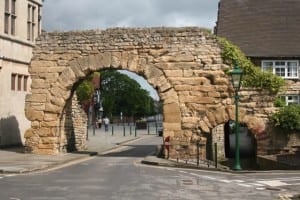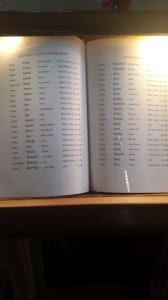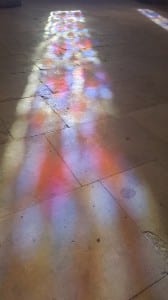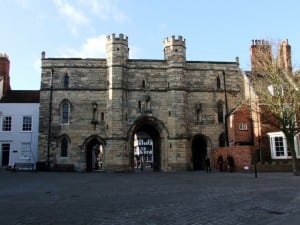Framing Statement
When first starting Site Specific, I was worried about what it would be like. I had heard mixed reviews on what we were going to have to do and why we were doing them, making me curious but weary of the module. My perspective on Site was negative to start off with as during the first lesson we had to immediately allow ourselves to be vulnerable in-front of our classmates, our teacher and strangers around the area; making me personally feel very uncomfortable. Our Site was based up in Castle Square and all around the Bail Gate area. For someone who doesn’t know Lincoln very well, I was surprised to see how far the outskirts went and what was up there. I hadn’t ventured very far up steep hill and I already started to notice things that I had never seen before; distressing me even more as I had to work in an environment that I knew nothing about.
Initially, I really struggled to find something that inspired me in Site Specific Drama. I was so used to working in a theatre or in a studio, on Naturalistic pieces of Drama, that the idea of working up a large hill with a Cathedral and high winds was not my idea of enjoyment or inspiration for a piece of Drama. I also did not know much about Site Specific Drama or why the artists included in it did what they did, therefore, I did not feel comfortable to start off with in this area; however, once we got started I became pretty open-minded about the different styles of work that we had to be involved in.
To start with, we wrote down a list of what we all wanted to focus on as a group. We thought this would help us narrow down our ideas into something that we all felt we would like to explore further.
Our Initial Group Ideas;
- Senses – blocking out certain senses and enhancing other ones.
- Footprints
- Audio, pictures and recordings
- Abstract – focusing on different energies
- Cathedral
- Hymns and choirs in the Cathedral
- RAF/Army/Military
- History
- Heights? – different levels
- Pathways – create your own
- What time of day? Sun Rise/Sunset
- Video/subtle mob
- Contrasting experiences
Eventually I started to get a little more curious about what I had to do and felt especially inspired by an artist called Janet Cardiff. She did a piece of work called ‘Memory Walk’. This walk is about following other people’s footsteps that have been there before us. “They will be aware that they are walking on the site just as others have walked over the same earth the last two hundred years, their stories mixing with those in the past.” (Cardiff, 2015) This inspired me as it made me think about ideas of walking over land which already has memories, like being trapped in a time warp of past events. We wanted our audience to experience what the people who had walked there before us had experienced, allowing me to understand roughly what Site Specific is all about, giving me more of an idea of what to expect in the module.
An Analysis of Process
During our time studying Site Specific, we were informed to look into a group of performers called Prototype. This group focuses on using audio to allow their members to receive information or instructions about what they have to do making the audience, not know that they are in-fact, audience members. We were inspired by this group which allowed us to think about what to focus on the most. To begin with, we wanted to do an idea that was about a ‘game’ where our users would get a piece of equipment that can be used for audio and there would be a set of questions or statements on the audio that they would have to follow. Some of these statements could say things that the individual would have to collect from someone or they would be told to run and would be advised to, making it exciting for the audience member. This led us to the idea of definitely using audio in our final performance and enabled us to think about a ‘game’ idea, but focusing on the Armed Forces; mainly the RAF and the Army. We decided that we could not focus on the game idea as we would have to use too many objects and it was too complicated, however we soon thought of new ideas.
The Cathedral was an inspiration in itself and shaped our final idea. Any building, that beautiful would be overwhelming to anyone especially to think that humans could have built something this memorising, let alone thousands of years ago. It is also a shock that the building is still standing, as there have been many natural disasters that could have and did jeopardize the Cathedrals condition. I was inspired by just being in Cathedral itself, the stain glass windows took my imagination to another place, all of the colours and shapes that I saw made me almost feel like a child seeing something new for the first time. I took inspiration from the different rooms that were based in the Cathedral, especially a War Memorial room which was full of flags, paintings and artefacts about World War II. There was an interesting looking book in a glass cabinet which I took a particular curiosity to, as in it, had the names of all the soldiers that fought in the war, when they died and in what way. This was something that I was motivated by as it was relevant to our Site Specific area and the area in and around the Cathedral.
We decided that we wanted to focus on doing two walks, one focusing on the RAF route and one focusing on an Earthquake. At this point we had found enough information on both to realistically think about what was going to work and what was not. We quickly realised that the RAF route was not feasible as there is not an RAF base in or near Lincoln that we could gain access to, pushing us completely onto the Earthquake idea, which we were all interested in.
We wanted our audience to go in two separate ways – have two separate walks, then meet in the middle, and either stop their walk or carry on to the other side and have a completely different experience. This is where the ‘Heaven and Hell’ idea originally sprouted from.
Before starting on the earthquake idea, we thought about another idea that we were eventually told to steer clear of because of Religious views, however it pushed us onto our final performance. This idea was based on a route about Heaven and Hell; we decided that Exchequer Gate would be the perfect place to start this piece as it is well known to most of the Lincoln public and is right next to the Cathedral. We also found that we could use the right hand arch as Heaven (as the right hand of God) the left hand arch as Hell (for the Devil) and the middle arch as purgatory. We thought of a few ideas that we could use, such as 10 points around the Cathedral that were relevant to religion in some way, where we could stop and express a about myth about that area. As we were told not to do this idea, it allowed us to think clearly about what we really wanted to do our piece about and it made us look deeper into what we could focus on and what would draw the audience in, taking us back to the Earthquake idea. After thinking about it properly we decided that would try and prepare ourselves to not change the idea again as we could not make our mind up for what we really wanted to do, so we decided to stay with this idea.
We went into the Cathedral to find a Hymn to sing in the audio for the final piece however we couldn’t use one because of copyright purposes. We had to think of something else to put in the audio so instead we used a dictionary definition of what an earthquake is and a letter insisting that anyone who has any information on the earthquake itself to help piece together the event.
We based our Site Specific performance on a devastating Earthquake that occurred in 1185, destroying most of the Cathedral that still stands today. We wanted to our audience to experience the fear and emotion that the people from the 1185 earthquake had felt, making an audio walk the best option for this idea. Our Site Specific Performance took place from Newport Arch to Exchequer Gate, on Wednesday the 6th May 2015 from 2-4pm.

(Geograph, 2006)
(Geograph, 2011)
Our audio for the walk consisted of one group member explaining what an earthquake is, and then it fades into a recording of the general public talking and the sound of someone softly playing the guitar. As the audio proceeds you hear several earthquake rumbles, a shop door opening and closing and then finally many rock slides, rumbles and a generic ‘earthquake’. This shows the overlapping of sounds as if it is past, present and future, referring back to Janet Cardiff’s Memory Field – “Here are also sound effects from battle scenes: cannons, muskets and horses galloping by. Time slips from one century to another as the listener walks, aware of their feet on the earth and the wind on their face.” (Cardiff, 2015) At the audios final point, it ends with another group member reading out a letter stating that anyone with any information on the 1185 earthquake, please step forward to the town council as then more information can be kept on it. Due to the cold, rainy and windy weather, we had a total of 5 audience members and were able to interview them at the end to acknowledge how they felt on their experience allowing us to see if our piece was successful or not. The feedback that we acquired enabled us to know that some audience members even felt goose-bumps on their experience, stating that they really felt connected with the audio and the area around them.
When it came to starting the audio, I was worried as I would have no idea where to start. Luckily, one member of the group had a device on his laptop that enabled him to mix all the sounds together. Because I didn’t know how to help with creating the audio, I felt it was best for me to stay out of that department and simply give my opinion on what I though was useable and what needed to be worked on. To start with, we needed to discuss, as a group what sounds we wanted in the audio and to know exactly what sounds we were looking for. We initially decided that we wanted general noise/background noise, such as people talking, a song of some sorts; a Hymn or a prayer, an Earthquake rumble and an actual Earthquake. However, we needed to record everything ourselves, what sounds we wanted to be included in the audio, so Steep Hill and the surrounding areas was the best place to find these sounds. This soon proved difficult as Steep Hill is a main tourist attraction; making a lot of the reordered sounds people shouting or babies crying, not knowing that this was eventually usable in our final track. Another problem that occurred was the wind, with Lincoln being known for having high winds, it made it impossible to record anything on a windy day because of the sensitivity of the microphone. This affected the quality of any recording that we did get, and just made a muffled sound – not giving us any useable recordings, or so we thought. When we listened back to the wind on the recordings, we found that it sounded like a quiet earthquake rumble, making most of the recordings with wind, useable for a small Earthquake rumble in the middle of the audio.
Another difficult aspect that we faced when producing the audio was trying to layer the sounds over each other to make it sound like the rumbles were happening over everyday life. We needed to make sure that rumbles were clear and effective and that they were occasional throughout the track. We also needed to make sure that the fades, from each recording were seamless so the audience would get the full experience without getting distracted from faults in the audio. It was vital to make sure that that everyone in the group was happy with the recordings and the process of the audio. If one group member wanted to change a part of the audio, it was important to discuss why and how we could achieve a sense of content throughout the group.
Lastly, it was interesting for me to hear the change in the audio, from start to finish. From listening to the recordings by themselves, to them being overlapped, changed and cut was fantastic, especially for someone who does not know a lot about audio. Finally, we wanted to add in speech at the beginning and the end to create a sense of closure in the audio.
https://www.youtube.com/watch?v=IYCMGL2QHTw&feature=youtu.be – A link to listen to the final track.
Evaluation
When it got to performance day, I was nervous about how the day was going to plan out. We were prepared for our piece to start and all we had to do was wait for our audience members to turn up and experience what we had planned. I was assigned to stand on the corner of Castle square and help anyone with any issues that they may have had with the audio, or the end part of the route. As I said before, overall we had 5 audience members and their reaction to our performance was noted after they had finished listening to the audio. One audience member stated that she, “found it really interesting and informative, it was a really good experience and I learnt things about Lincoln that I didn’t know”, this states that her experience was informative which was not the main intention for our performance but it is optimistic making it a strength in our piece. Another strength of our performance would be in the audio itself; the end section with the main earthquake gave myself and several of our own group member’s goose-bumps when listening to it for the first time, achieving our original goal of making the piece emotionally effective. However, a weakness occurred when watching some of the audience members on the route. I felt that some individuals were very unsure about where to go on the route and I was asked by one audience member which way the route continued, “at the start tell people exactly where to go, I got a bit confused”. This distracted this individual from the main purpose of the performance; to feel like they were in a different time, resulting in the audio not having a full effect on its user. Another obvious weakness to us was the weather. The rain obstructed most of our invited audience members but overall I was happy with having 5 as it is better than zero.
I feel the final performance could have been improved by making the route longer so the audience members were not stood at the Cathedral for so long and so that when they did get to the Cathedral the Earthquake was more of an instant shock. I would change the piece so that the audience members didn’t just listen to something, instead I would make it so that they received instructions on what to do, at certain points in the route, so that they didn’t feel like they were doing the performance alone, or didn’t get confused about why or what they were doing there. This would have cut out the confusion with the route all together as in theory; the audience member would have the choice on where to go. This is where I feel that Janet Cardiff was a big inspiration to me as I loved the idea of our audience members almost travelling through time and experiencing something that happened 830 years ago, in 2015, when most of the Cathedral has been changed in colour, re-built and expanded.
References
Cardiff, J. (2015). Janet Cardiff & George Bures Miller. [online] Cardiffmiller.com. Available at: http://www.cardiffmiller.com/ [Accessed 15 May 2015].
Geograph, (2006). Newport Arch. [image] Available at: http://www.geograph.org.uk/photo/173894 [Accessed 15 May 2015].
Geograph, (2011). Exchequer Gate. [image] Available at: http://www.geograph.org.uk/photo/2716365 [Accessed 15 May 2015].
George Murphy (2015) Disturbance Audio Walk. [online video] Available from https://www.youtube.com/watch?v=IYCMGL2QHTw&feature=youtu.be [Access 15 May 2015].



